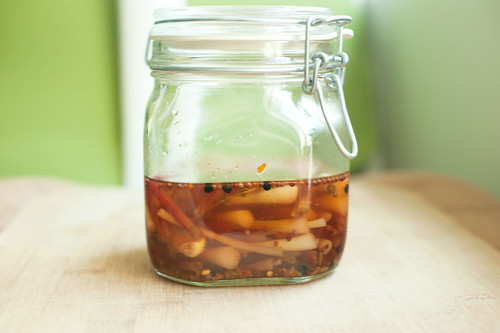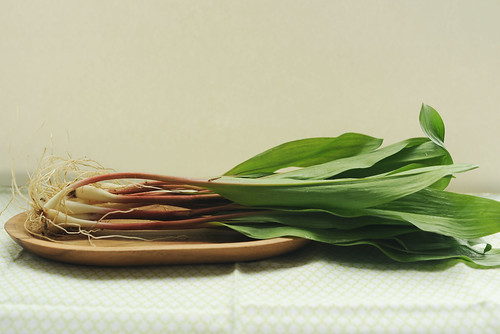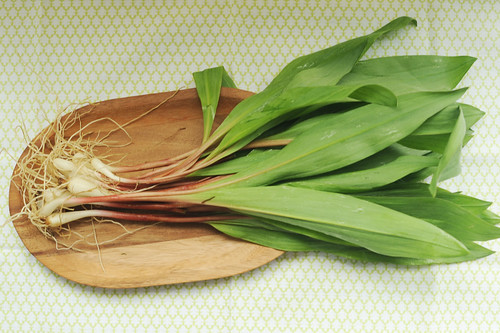pickled ramps
A few weeks ago, I was catching up with my parents on the phone. The conversation went a little bit like this, “So, I just got back from the market and ramps are back in season!”
Silence.
I tried again. “So, like I said, I picked up some eggs and milk and potatoes, and also ramps are back, and I’m going to pickle them, so I’m excited about that.”
My mother spoke up, “What are ramps?” she asked me in Russian. My dad piped in, “Never heard of ramps. How do you say in Russian?”
And this is where my mind drew a blank. Not only did I not consider that ramps weren’t part of our Russian diet, I didn’t know the Russian word for it. And trying to explain an unknown ingredient to someone is a challenge – no matter what vocabulary you use, you still fall woefully short of the actual thing. To know an ingredient, you have to taste it.
Normally, I’m much more on top of English-to-Russian translations of produce. I often discuss food with my parents, pick their brain on how we would cook something in Russia, so it’s not uncommon for us to talk about sorrel, nettles, chanterelles, among a few. Somehow, I failed to consider that, in fact, there is no Russian word for “ramps” because ramps are not native to Russia.
The closest relative, so to speak, is wild garlic known as “cheremsha” which grows for a few short weeks in the spring and, due to its short season, is normally pickled. My parents introduced me to it a few years ago, when they came to visit and brought with them a few Russian deli provisions, pickled cheremsha among them. It quickly became my favorite snack and replaced the less-than-exciting celery in my Sunday Bloody Mary.
Ramps are, obviously, not cheremsha, but I also find them an excellent candidate for pickling. In fact, it is my favorite way of eating them, and it extends my ramp-enjoying season, so to speak. After they’re ready, I throw them in a martini, or periodically fish them out of the jar, whenever I’m hankering for a snack. Lately, I’ve been hiding them in a layer of thick, creamy ricotta slathered over rustic sourdough bread. And last year, over at one of my favorite restaurants, Hearth, pickled ramps were served alongside salty, briny mackerel.
Best part is that you don’t have to wait too long to taste your creation – the pickling process takes about two days and stores for months and months refrigerated. Though I don’t think that our batch will survive the spring. Which is too bad, because I sure would have loved to share some ramps with my parents – so they could finally learn not only their meaning, but their unforgettable flavor.
Pickled Ramps
Adapted from the Gramercy Tavern via Natural Health Magazine
Cleaning ramps is probably the worst part of the whole process. They get muddy and sandy and you want to be really careful with getting all that grit out – believe me, it doesn’t taste great. After your ramps are clean, you want to separate out the greens from the white parts. You’ll pickle the lower parts, but by no means throw out the greens out – they make a wonderful addition to pastas, wilted for a few minutes in a pan with a little garlic and dissolved anchovy. Also, keep in mind, that when all is said and done, those white parts are tiny and your pickled ramp amount will most likely be small. This means you need to buy a lot of ramps. Which means you probably need to shell out a lot of money. Which is not something I am in favor of doing especially given the precarious state of the economy. However, if you use these ramps are your martini garnish, unless you have a martini-a-day habit (nothing wrong with it), these ramps might last you awhile. Which means, you could stretch the cost quite far. But still – cheap they are not. And if there’s an area near you where wild ramps grow free, go forth and capitalize on this mighty bounty. It’ll be well worth it.
Ingredients:
1/2 pound ramps, cleaned, green leaves removed
1/2 cups white wine vinegar
1/4 cup water
1/4 cup demerara sugar
1 garlic clove
1/8 teaspoon fennel seeds
1/8 teaspoon coriander seeds
1/8 teaspoon mustard seeds
1/8 teaspoon whole black peppercorns
1/8 teaspoon hot chili flakes
1 sprig thyme
1/4 teaspoon coarse kosher salt
Preparation:
1. Bring a large pot of water to boil and blanch ramps, about 1 minute.
2. Chill ramps in an ice bath. Drain.
3. Add remaining ingredients to a pot, bring to a boil then simmer for 10 minutes. Allow time for liquid to cool completely.
4. Pour cooled pickling liquid over ramps and store in a container with a tight lid. They will be ready to eat in two days and can be stored, tightly sealed, in the refrigerator for months.




Ruth
These pickled bulbs look great.
I’m in the UK and we have these – wild garlic, also known as ramsons they are found all over europe – so in Russia too, I imagine:
http://en.wikipedia.org/wiki/Ramsons
ilya
I always, though it seems incorrectly, thought that “черемша” is pickled shoots of any garlic. But, in any case, anything pickled is good :).
nicole
What Ruth said. I’m in germany and we call it Baerlauch, which apparently are ramsons. They taste of garlic but are a bit milder and not as stinky, if you know what I mean?
Radish
Ruth and Nicole – yes, I do, I mention this in my post, in Russia we called it Cheremsha.
Christine
Oh ramps, how I love them. This seems like a pretty genius way of stretching out the ramp goodness by pickling the bottoms, which I’ve always sauteed with the greens. (I find they’re particularly delicious as a bed for some nicely seared scallops. YUM.)
Katie
I have not seen ramps out here in Northern California. Either I’ve missed them–or they’re grown and eaten mainly on the East Coast ? I’ll have to do a little research on this…
Milica
I must be on the look out for ramps in NY. I love cheremsha and anything pickled appeals to me. I also get that same thing when talking to Russian family, if I come across the word that I can’t translate I’ll just say the English. Usually I am met by confusion.
Juanita
I had never heard of these wild garlic bulbs until I came across a UK gardening blog recently. I like the name “ramps”, it’s a quirky one!
Roze
Ramps are an East Coast native…pretty much from Southern Appilachia to Canada is what I understand. Here’s a great article from J. Kenzi Lopez of Serious Eats that may help everyone understand them better:
http://www.seriouseats.com/2011/04/enough-with-the-ramp-rage-rant.html
There’s concern for those ramps found in the wild being over harversted, so if you know of a patch in your area, take care not to take them all, so there’s more for the following year.
Pickle on, folks!!!
Katie@Cozydelicious
I love the idea of pickling ramps. I usually try to eat the whole short season’s worth in one week! This is way better!
Kimberley
This reminds me of once talking about some Russian green with a colleague who didn’t know its name in English. We figured it out, though, with the help of Wikipedia.
Ramps are retardedly expensive out here, but I’m making these regardless. I love them
Brian @ A Thought For Food
What a great way to preserve them! Looks glorious.
Jess
Absolutely lovely! Thyme – I wish I thought of that! Your recipe (and this entire blog) looks simply delicious. I look forward to coming back!
nancy
I tried pickling spring garlic for the first time last week (I had an eye out for ramps but the little greenmarket near me didn’t have them), with hot pepper flakes and mustard seeds. Delicious! If I can get my hands on ramps this week I’m going to try your method — plus they’re a perfect excuse to make a bloody mary :)
Sarah
Wow. I totally had oven roasted ramps for dinner. Tossed ’em in olive oil, sea salt, and black pepper, and then roasted on a sheet pan at 450 F for maybe 15 or 20 minutes until the leaves get crispy. SO GOOD. I don’t know if I would have the heart to pickle them… Lol.
Pille @ Nami-Nami
Lovely post!
I’ve got a similar “problem”. Living in Estonia, we only have ramsons (Allium ursinum), and no ramps (Allium tricoccum, – лук канадский in Russian, btw). So whenever I blog about ramson dishes (and I’ve done that a lot), I need to mention that although ramsons are not available in the US, you can easily substitute with ramps :)
Valentina
The original author is incorrect. Ramps are “cheremsha” is Russian. They are very prominent in colder climate and are a staple in Siberia and Kamchatka.
Radish
Valentina – I must disagree with you. I’ve had both ramps AND cheremsha and they taste very different to me. No doubt they are related, but based on what my taste buds tell me, they are not the same thing.
sweet potato patties | Sassy Radish
[…] somehow to be present this Passover. It’s not so late in the spring that it’s all asparagus and ramps. Plus, for reasons I can’t quite explain, they taste so good to me right now. Always a sweet […]
ramp pesto | Sassy Radish
[…] can also just pickle them. They last a year (or longer) and are pretty ridiculous in cocktails (think bloody marys par […]
fregola sarda with peas, zucchini, feta, and almonds | Sassy Radish
[…] apple. Elsewhere in the fridge, there was jars of mustard, anchovies, harissa, mayonnaise, capers, pickled ramps from last year, preserved lemons, homemade sauerkraut I’ve been aging for soup, and (obviously) […]